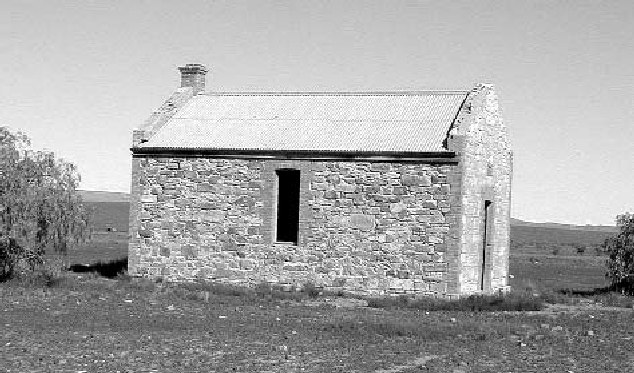
- •Intelligent houses
- •Preindustrial interiors: structure and space
- •Fig. 1. The Skeleton of a Simple Building
- •Machine-age interiors: dominance of mechanical and electrical systems
- •Fig. 2. Mechanical and Electrical Networks
- •Fig. 3. A two-storey house
- •Text c
- •1. A wall
- •Fig. 4. Smart Pot
- •Video Monitor
- •Smart Air Conditioner
- •Intelligent houses
- •Fig. 5. Buildings of the 21st century are acquiring electronic nervous systems
- •Fig. 6. Intelligent Systems
- •Unit 5 building materials
- •In our everyday lives, but define the environment in which we live.
- •Materias for construction
- •Text d bricks
- •Steel and other metals
- •Text g glass
- •In your group discuss what materials you would choose and why. Then present it to others, explaining your decision.
A
typical preindustrial building, the elementary house of an
agricultural worker, is shown in its ruined state in Figure
1.
It consists of a single rectangular space with doors at either end
and windows on opposite sides. Its basic function was simply shelter.
The stone walls and the iron roof provided protection from
the wind and the rain, and relief from the heat of the sun. The walls
minimized extremes of heat and cold by supplying insulation, and
through their thermal mass, they would heat up in the warmth of the
day, then reradiate thermal energy to the interior in the cool
evenings. When these passive strategies did not help, a fireplace
produced additional heat. The door and window openings provided
connection to the exterior. They could be opened and closed manually
to vary the flow of air. And, through filtering mechanisms such as
shuttersand blinds, they provided the ways to control interior light,
view, and gave protection from bugs and dust. 
Fig. 1. The Skeleton of a Simple Building
The interior was not subdivided, like in a modern home, into specialized rooms. Instead, the space was adapted for different purposes at different times. Very simple, mostly portable furniture was used. There was a bed for sleeping, a table and chairs for eating and reading, and a water basin for washing. The fireplace served as an elementary cooking device. And a lavatory was outdoors.
There were no pipes and wires in the walls and under the floor, no mechanical or electrical devices, no demands for the services of plumbers and electricians. Water was supplied from a rainwater tank fed by runoff from the roof. Firewood was cut from the surrounding trees and hand-carried to the fireplace. There was an evaporative cooler hanging in the branches of a nearby tree.
Exercise 5. Answer the questions.
1. What are the main components of a simple preindustrial building?
2. What was the main function of this building?
3. The stone walls and the iron roof provided protection from dust, didn't they?
5. Was it warm in the house in the cool evenings?
4. Did a preindustrial building have several rooms?
5. What kind of furniture was used in such houses?
6. Was a lavatory indoors or outdoors?
7. How was water supplied to the house?
Exercise 6. Match the beginning of the sentence to its ending.
1. A typical preindustrial building consists of ...
2. The walls minimized extremes of heat and cold by...
3. The door and window openings provided...
4. The fireplace served as...
5. There were no...
A. connection to the exterior.
B. supplying insulation.
C. an elementary cooking device.
D. a single rectangular space with doors at either end and windows on opposite sides.
E. pipes and wires in the walls and under the floor.
Exercise 7. Complete the table.
|
PART OF A HOUSE |
FUNCTION |
|
(1) ... |
Protection from the wind and the rain, and relief from the heat of the Sun. |
|
Fireplace |
(2) ... |
|
The door and the window openings |
(3) ... |
|
(4) ... |
Control of interior light, view as well as protection from bugs and dust. |
|
Bed |
Sleeping |
|
A table and chairs |
(5) ... |
|
(6) ... |
Washing |
Exercise 8. Translate from Russian into English.
Простейшее здание состояло из каменных стен, железной крыши, дверей и окон на противоположных сторонах.
Благодаря своей теплоёмкости каменные стены защищали от жары и холода.
Камин обеспечивал жилище дополнительным теплом.
Ставни и занавески являлись механизмами фильтрации, которые защищали интерьер от жучков и пыли.
Внутреннее пространство дома не было разделено на комнаты.
Мебель была очень простой. Была кровать, стол, стулья и раковина.
Туалетбылнаулице.
В доме не было труб и проводов, поэтому услуги сантехников и электриков были не нужны.
Воду брали из ливневого резервуара.
Дрова для камина приносили из близлежащих лесов.
Text B
Exercise 9. Match the words with their definitions.
A. Suburban.
B. Interrelationship.
C. Require.
D. Select.
E. Fixtures and appliances.
F. Construction drawing.
G. Locate.
H. Internal networks.
I. Utility networks.
J. Warehouse.
1. A big building where large amounts of goods are stored.
2. To choose.
3. A building plan.
4. The way in which two or more things affect each other.
5. To put something in a particular place.
6. Water supply, sewerage and electricity.
7. To need something.
8. Furniture or equipment.
9. Out-of-town.
10. Pipes and wires inside the house.
Exercise 10. Give each group of words its correct heading from the list.
Utilities Electrical system Rooms
Types of buildings Plumbing
1. A bedroom, a living room, a dining room, a kitchen, a bathroom, a garage.
2. Hot and cold water supplies, HVAC, gas supply, electricity.
3. Faucets and valves.
4. Switches and dimmers.
5. Offices, factories, warehouses, schools, hospitals, laboratories.
Exercise 11. Read and translate the text.
